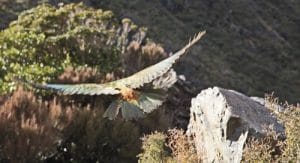October 2020 – March 2021
Over the past 6 months, a total of 121 kea have been blood lead tested at 10 key sites (Arthurs Pass, Fiordland (Kepler Track, Milford Track, Milford Rd, Stuart Mountains, Murchison Mountains), West Matukituki, Mt Aspiring NP, West Coast (Okarito, Haast and Franz Josef township). This brings the total of kea tested under this programme to 439.
Arthur’s Pass
One very sick kea, Hohora, from Arthurs Pass village was taken in for chelation treatment on New Years eve and a further 3 kea were tested on the 1st of March 2021. Two of these birds from the village returned extremely high blood lead levels (>49.5).
Fiordland
As part of our ongoing kea monitoring work in Fiordland, 45 kea were tested in the Stuart and Murchison Mountains, the Kepler and Milford Tracks and along the Milford Road (from Homer Tunnel through to Milford Lodge).
Results pending.
West Matukituki Valley, Mt Aspiring NP
A total of 25 kea were blood lead tested at the end of February 2021. This area has historically returned very low blood lead results with the first tests being carried out by DOC in 2008 and further testing in the area carried out by the KCT in 2016. Because kea in this area have made a significant come back in the past year, it was felt to be a good time to retest these birds. Unfortunately four of these birds returned very high blood lead levels, two off the scale (>65 μg/dL) which indicates they are accessing lead somewhere in the valley.
West Coast (Okarito, Franz Josef and Haast)
A total of 47 birds were blood lead tested between Oct 2020 and the beginning of April 2021. Four of these birds returned levels >20 μg/dL (one of which was >65 μg/dL).
June 2020 – September 2020 Outcomes
A number of lead testing catch trips ran in the second half of 2020 (from June – September) taking the number of kea blood lead tested to 318. These included the following:
Arthur’s Pass
- August 7-9th: 6 kea were banded and blood lead tested with one (Snoop) registering high blood lead levels. he was taken into the South Island Wildlife Hospital for chelation treatment. Another kea, Evan, was also taken to the hospital for surgery on a broken leg.
- Sept 3-4th – Three kea banded and lead tested. Three kea banded and lead tested. All three (Rose-Aniya, Robin Hood and William Finn) returned high blood lead levels and were taken to the SIWH for treatment. All kea were fitted with radio transmitters to monitor their survival post-release. As of Feb 2021 all were returning active signals. However, Evan who was fitted with a radio transmitter and followed for a few months after being released into the wild in August, was found dead in December 2020 – his injuries and time spent in captivity likely hindering his chances of survival in the wild.
Golden Bay
- June – Nine kea were banded and blood lead tested with all returning low levels.
Franz Josef/Okarito Westland
- August 13-17th – Ten kea banded and blood lead tested. One returned high levels (Mingo) and was taken to the SIWH for treatment.
2018 - 2020
A total of 270 kea have been blood lead tested by the KCT (to March 2020), in predominantly "front country" sites (ie around human habitation) in Fiordland, in South Westland, Aoraki Mt Cook, Arthur's Pass, at ski fields and at Nelson plantation forestry sites. Many of the kea at these sites have returned concerningly high blood lead levels.
Additional kea have been tested in "back country" sites in Fiordland (the Murchison and Stuart Mtns) and Mt Aspiring National Parks Matukituki Valleys. The majority of these kea have returned very low blood lead levels.
Community and funder involvement is vital to ensure this work goes ahead. One of our funders Denver Zoo from America has provided not only funding to support the purchase of equipment towards this work, but also sent one of their kea staff members, Jessica Meehan to New Zealand in February (18th -27th 2020) to help and learn about kea conservation in-situ.
Read all about Jessica’s experience here!
Locations
To March 2020 – Forty-six kea were tested along the Milford Highway (the Chasm carpark, Homer Tunnel east, Monkey Creek), Milford Sound, Luxmore and Moturau huts on the Kepler Track, and at West Arm Manapouri.
Only four of these birds tested high (>20.1 μg/dL) for lead poisoning; one of these was extremely high (>65 μg/dL) – a fledgling female caught and tested at Homer tunnel. The other three with high lead levels were caught at Moturau Hut on the Lake Manapouri side of the Kepler track. From information sent to the Kea Sightings Database on banded kea movements, we can see that kea in this area are making many long-distance movements between West Arm, the Murchison mountains and one even traveled to the Kepler area from as far away as Shy Lake in the south west of Fiordland. Even though most kea tested below the 20 μg/dL level that we call deem risky for their functioning and survival, a further ten kea still had blood lead levels >10 μg/dL, suggesting that lead is still present and a part of the environment in certain areas, especially around sites visited at Manapouri. While working at Homer Tunnel east, we also discovered vast quantities of soft malleable lead weight material and old lead head nails (leftover from the destruction of buildings post-Homer tunnel completion) deposited in among the boulders in the cirque area. We picked up >5kg after an hour’s searching during March 2019, but there is certainly a lot more present which the community and Te Anau DOC team are currently addressing.
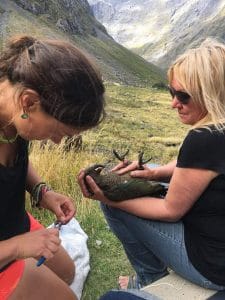
South Westland – Fourteen kea have been lead tested in South Westland so far – nine near Okarito (Forks and Pakihi walkway area) and five in Franz Josef township. Surprisingly, lead levels were reasonably high overall, with all but three kea having blood levels >12 μg/dL and three with lead poisoning (>20 μg/dL); two of these being extremely high (>50 μg/dL). Three kea lead-tested and banded at the Forks during March 2019 were sighted high up in the Perth valley, all the way up near the main divide of the Southern Alps during July 2019. This demonstrates significant long-distance movements from the coast to the divide, bringing about more questions about the source of lead for these kea and the complexities that come about with solving these issues. Either these kea spent time around lowland areas in areas where lead materials were present on roofs, high up in the mountains feeding on tahr carcasses shot with lead ammunition or a combination of both, but this issue is a pressing one that requires urgent further investigation. As of winter 2019, lead-based ammunition was ceased in tahr culls in South Westland but we know from research on kea lead levels in the Perth Valley as part of work undertaken by Zero Invasive Predators (ZIP) that lead toxicity is prevalent in the kea population there.
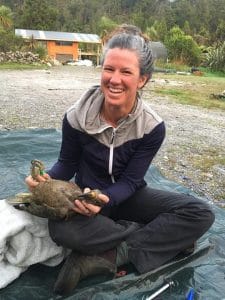
Aoraki/Mt Cook – The issue of lead poisoning in kea was first flagged in 2006 by the Department of Conservation after extensive testing of birds in the area found high blood lead levels in the population. They have been largely absent from Mt Cook since 2010 but in 2019 have made a significant comeback in numbers to Mt Cook village and a 20km radius around it. In two trips to the area in March and October 2019, nine kea were tested for lead; seven of those had high lead levels. The two that were did not show lead poisoning were both adults, the rest were young birds.
Ski fields – Nine kea have been tested for lead at three ski fields – five at the Remarkables, two at Treble Cone and two at Porters. Blood lead levels were generally well within the acceptable limits, especially at the Remarkables where all were <5 μg/dL. One kea at both Porters and Treble Cone were >10 μg/dL however.
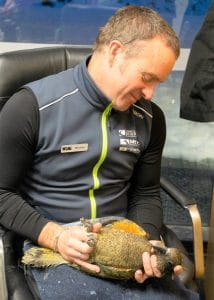
Plantation Forestry sites in north-west Nelson – So far we have visited two forestry sites where kea frequently visit, sometimes in large numbers (flock sizes >15). We have lead tested two kea at Batons and three at Spooners forestry sites and all have returned satisfyingly low blood lead results (all <6 μg/dL).
Arthur’s Pass and Surrounding areas – Seventy-nine kea in Waimakariri area (an area largely within Arthur’s Pass National Park including the Hawdon valley in the south-east, and west to Arthur’s Pass village, Temple Basin ski area and the Otira viaduct lookout sites (key kea catching spots where research is being carried out)) have now been blood lead tested. Thirty-three of these kea returned high lead levels (>20 μg/dL).
Those kea caught <10km of the village generally tested high for lead. Young male kea, particularly fledglings, have exceptionally high lead levels with >90% of the 11 male fledglings and >70% of the 15 male juveniles tested returning very high blood lead level results. Adults in the area had generally lower blood lead levels.
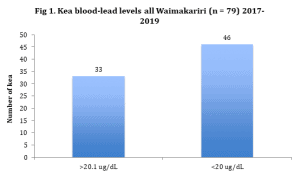
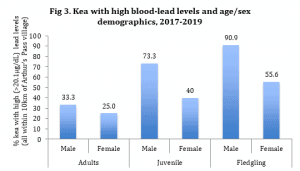
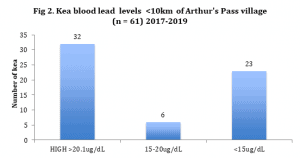
Treatment of lead-poisoned kea
Thirteen Arthur’s Pass kea have been taken to the South Island Wildlife Hospital vets in Christchurch for chelation since 2016 and most have responded positively and been successfully released. Each kea receives 1-3 rounds of chelation treatment (using EDTA) depending on their blood lead level. The lead in their blood is bound up by this process and excreted from their system through natural processes. Once the birds’ lead level has reached an acceptable level (<5 μg/dL), they are released back to the wild, never usually back into the village, but usually within 20km east or west of there. Most birds survive in the wild post-release and are spotted again alive and well. Only one kea – Iwa – died shortly after release, from lead poisoning and related complications (parasite loading being a common related factor).
